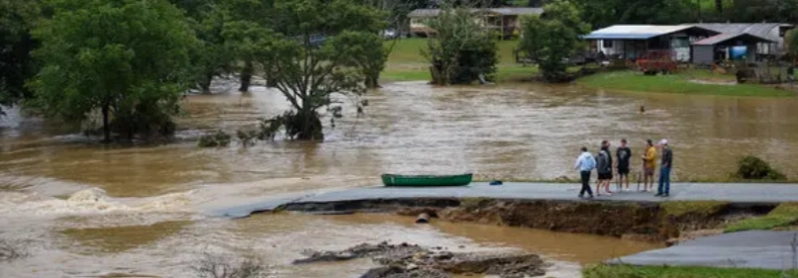The Aftermath of Hurricane Helene: A Community’s Struggle in Western North Carolina
Introduction
Hurricane Helene made landfall on September 26, 2024, in Florida’s Big Bend region as a Category 4 storm, before sweeping through the southeastern U.S. and causing catastrophic damage in western North Carolina. The aftermath has left communities grappling with unprecedented destruction, loss of life, and a long road to recovery.
This article explores the devastating impact of Hurricane Helene on western North Carolina, highlighting personal stories, community responses, and ongoing recovery efforts.
The Path of Destruction
As Hurricane Helene moved inland, it transformed from a powerful hurricane into a tropical storm but continued to unleash torrential rainfall across the Appalachian region. The North Carolina State Climate Office reported that some areas received over 31 inches of rain within three days, leading to catastrophic flooding and landslides.

The town of Asheville and surrounding areas became inundated, with rivers overflowing their banks and transforming roads into rivers.
Record-Breaking Rainfall
The rainfall from Helene was described as “biblical,” with many weather stations recording their highest levels ever. This unprecedented precipitation caused severe flooding, particularly in small towns that often lack robust infrastructure to handle such extreme weather events. The Swannanoa River surpassed its highest-ever crest by several feet, marking a new record for flooding in the region.
Human Toll and Community Impact
 The human cost of Hurricane Helene is staggering. Reports indicate that over 100 lives have been lost across the affected states, with North Carolina bearing a significant portion of this tragedy. Communities like Montreat and Swannanoa have been described as “gone,” with entire neighbourhoods destroyed. First responders have faced overwhelming challenges as they work tirelessly to rescue individuals trapped by rising waters and landslides.
The human cost of Hurricane Helene is staggering. Reports indicate that over 100 lives have been lost across the affected states, with North Carolina bearing a significant portion of this tragedy. Communities like Montreat and Swannanoa have been described as “gone,” with entire neighbourhoods destroyed. First responders have faced overwhelming challenges as they work tirelessly to rescue individuals trapped by rising waters and landslides.
Personal Stories of Loss
 Among those affected are Kim and Rod Ashby from Elk Park, whose home was swept away by floodwaters. Their story is just one of many that illustrate the profound impact of the storm on families throughout the region. Volunteers have reported that the smell of death hangs heavy in the air as they navigate through devastated neighbourhoods, searching for survivors and providing aid to those in need.
Among those affected are Kim and Rod Ashby from Elk Park, whose home was swept away by floodwaters. Their story is just one of many that illustrate the profound impact of the storm on families throughout the region. Volunteers have reported that the smell of death hangs heavy in the air as they navigate through devastated neighbourhoods, searching for survivors and providing aid to those in need.
Infrastructure Devastation
The infrastructure damage caused by Hurricane Helene has been extensive. Over 400 roads were reported closed due to flooding and landslides, making it difficult for emergency services to reach isolated communities. Power outages affected millions across multiple states, with Duke Energy reporting significant damage to substations and power lines.
Challenges in Recovery
Recovery efforts are complicated by the mountainous terrain of western North Carolina. Many small towns have limited access points, which have been blocked by fallen trees and debris. As local officials work to assess the full extent of the damage, they face significant logistical challenges in delivering aid to those who need it most.
Government Response and Aid
In response to the devastation caused by Hurricane Helene, Governor Roy Cooper declared a state of emergency for several counties in western North Carolina. FEMA has mobilized resources to assist with recovery efforts, but many residents are still waiting for help as they cope with loss and uncertainty.
Community Resilience
Despite the overwhelming challenges, communities have begun to band together. Neighbours are helping each other clear debris and provide essential supplies like food and water. Local organizations are stepping up to offer support, demonstrating incredible resilience in the face of adversity.
Looking Ahead: A Long Road to Recovery
As recovery efforts continue, experts warn that it will take years to fully document and address the impacts of Hurricane Helene. The emotional toll on residents is immense; many are still grappling with grief over lost loved ones and homes.
Preparing for Future Storms
The devastation wrought by Hurricane Helene serves as a stark reminder of the increasing frequency and intensity of severe weather events linked to climate change. Communities must now consider how best to prepare for future storms while rebuilding from this disaster.
Conclusion
Hurricane Helene has left an indelible mark on western North Carolina, transforming vibrant communities into landscapes of destruction. As residents work tirelessly to recover from this catastrophe, their stories serve as powerful reminders of resilience in the face of unimaginable challenges. The road ahead may be long and fraught with obstacles, but together, these communities will strive to rebuild their lives and homes.
